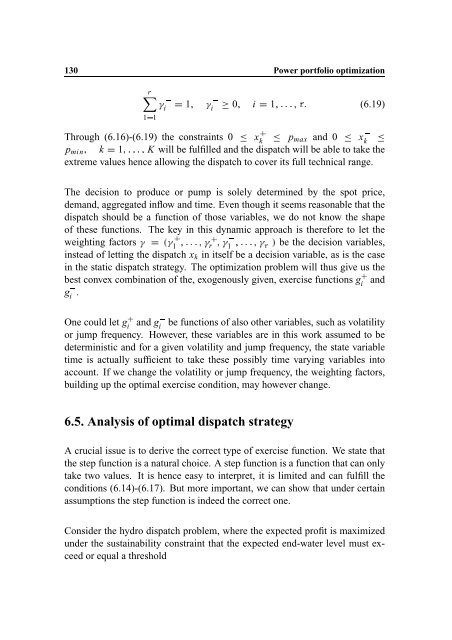Hedging Strategy and Electricity Contract Engineering - IFOR
Hedging Strategy and Electricity Contract Engineering - IFOR
Hedging Strategy and Electricity Contract Engineering - IFOR
You also want an ePaper? Increase the reach of your titles
YUMPU automatically turns print PDFs into web optimized ePapers that Google loves.
ë<br />
ì<br />
á<br />
130 Power portfolio optimization<br />
r<br />
1â 1<br />
ì õ 1Ü õ ì<br />
i<br />
0Ü<br />
i<br />
1Ü i<br />
(6.19)<br />
Ükô<br />
Through (6.16)-(6.19) the constraints 0 xëk<br />
p max <strong>and</strong> 0 x ìk<br />
p min k 1Ü Ü K will be fulfilled <strong>and</strong> the dispatch will be able to take the<br />
Ü<br />
extreme values hence allowing the dispatch to cover its full technical range.<br />
á@á?á<br />
á?á@á<br />
The decision to produce or pump is solely determined by the spot price,<br />
dem<strong>and</strong>, aggregated inflow <strong>and</strong> time. Even though it seems reasonable that the<br />
dispatch should be a function of those variables, we do not know the shape<br />
of these functions. The key in this dynamic approach is therefore to let the<br />
Û õ weighting factors ë1<br />
Ü õ<br />
r Ü õ ì<br />
1 Ü Ü õ<br />
õ<br />
ö Ý be the decision variables,<br />
á?á@á<br />
Ü á?á@á<br />
instead of letting the dispatch x k in itself be a decision variable, as is the case<br />
in the static dispatch strategy. The optimization problem will thus give us the<br />
best convex combination of the, exogenously given, exercise functions gëi<br />
<strong>and</strong><br />
i<br />
. gì<br />
One could let gëi<br />
<strong>and</strong> gìi<br />
be functions of also other variables, such as volatility<br />
or jump frequency. However, these variables are in this work assumed to be<br />
deterministic <strong>and</strong> for a given volatility <strong>and</strong> jump frequency, the state variable<br />
time is actually sufficient to take these possibly time varying variables into<br />
account. If we change the volatility or jump frequency, the weighting factors,<br />
building up the optimal exercise condition, may however change.<br />
6.5. Analysis of optimal dispatch strategy<br />
A crucial issue is to derive the correct type of exercise function. We state that<br />
the step function is a natural choice. A step function is a function that can only<br />
take two values. It is hence easy to interpret, it is limited <strong>and</strong> can fulfill the<br />
conditions (6.14)-(6.17). But more important, we can show that under certain<br />
assumptions the step function is indeed the correct one.<br />
Consider the hydro dispatch problem, where the expected profit is maximized<br />
under the sustainability constraint that the expected end-water level must exceed<br />
or equal a threshold
















